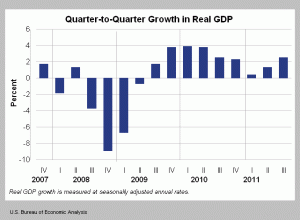Expansionary Fiscal Contraction
by Paul Ormerod
To many people, this phrase is an oxymoron. How can fiscal contraction be expansionary?
But the evidence suggests that this is exactly what has been happening in the United States.
In terms of national output, GDP, the trough of the trough of the recession was reached in the second quarter of 2009 (2009Q2). We have now had nine successive quarters of positive growth, and in 2011Q3 the level of output is above that of its peak level before the recession started. Growth has not been as strong as would be desirable, but there has been consistent growth. On any measure, the recession is over.
 Where has the growth come from? Not from public spending! Between 2009Q2 and 2011Q3, current public expenditure in real terms fell by $38 billion, or by some 1.5 per cent.
Where has the growth come from? Not from public spending! Between 2009Q2 and 2011Q3, current public expenditure in real terms fell by $38 billion, or by some 1.5 per cent.
The private sector grew, the public sector contracted. Private consumption rose by $450 billion, nearly 6 per cent, and capital spending by firms rose by $200 billion, or nearly 13 per cent. There was a slight deterioration in the net export position, but overall the private sector delivered growth.
The employment figures tell the same story. Employment changes tend to lag what happens to output, and the lowest level of total employment was not reached until February 2010, when 129,200,000 people were employed.
Between then and September 2011, public sector employment fell by nearly 500,000. But private sector employment rose by over 2.5 million, to give a net increase of almost 2.1 million.
The lessons for Europe are to have a co-ordinated fiscal contraction.
